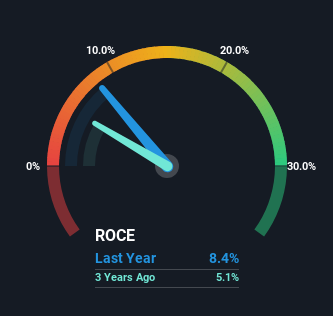Investors Met With Slowing Returns on Capital At Exchange Income (TSE:EIF)
There are a few key trends to look for if we want to identify the next multi-bagger. Firstly, we'll want to see a proven return on capital employed (ROCE) that is increasing, and secondly, an expanding base of capital employed. Basically this means that a company has profitable initiatives that it can continue to reinvest in, which is a trait of a compounding machine. In light of that, when we looked at Exchange Income (TSE:EIF) and its ROCE trend, we weren't exactly thrilled.
What Is Return On Capital Employed (ROCE)?
If you haven't worked with ROCE before, it measures the 'return' (pre-tax profit) a company generates from capital employed in its business. Analysts use this formula to calculate it for Exchange Income:
Return on Capital Employed = Earnings Before Interest and Tax (EBIT) ÷ (Total Assets - Current Liabilities)
0.084 = CA$290m ÷ (CA$4.1b - CA$619m) (Based on the trailing twelve months to December 2023).
Therefore, Exchange Income has an ROCE of 8.4%. In absolute terms, that's a low return but it's around the Airlines industry average of 9.1%.
See our latest analysis for Exchange Income
In the above chart we have measured Exchange Income's prior ROCE against its prior performance, but the future is arguably more important. If you'd like, you can check out the forecasts from the analysts covering Exchange Income for free.
What Does the ROCE Trend For Exchange Income Tell Us?
There are better returns on capital out there than what we're seeing at Exchange Income. The company has employed 101% more capital in the last five years, and the returns on that capital have remained stable at 8.4%. This poor ROCE doesn't inspire confidence right now, and with the increase in capital employed, it's evident that the business isn't deploying the funds into high return investments.
The Bottom Line
In summary, Exchange Income has simply been reinvesting capital and generating the same low rate of return as before. Since the stock has gained an impressive 81% over the last five years, investors must think there's better things to come. Ultimately, if the underlying trends persist, we wouldn't hold our breath on it being a multi-bagger going forward.
If you want to know some of the risks facing Exchange Income we've found 3 warning signs (2 are a bit unpleasant!) that you should be aware of before investing here.
While Exchange Income may not currently earn the highest returns, we've compiled a list of companies that currently earn more than 25% return on equity. Check out this free list here.
Have feedback on this article? Concerned about the content? Get in touch with us directly. Alternatively, email editorial-team (at) simplywallst.com.
This article by Simply Wall St is general in nature. We provide commentary based on historical data and analyst forecasts only using an unbiased methodology and our articles are not intended to be financial advice. It does not constitute a recommendation to buy or sell any stock, and does not take account of your objectives, or your financial situation. We aim to bring you long-term focused analysis driven by fundamental data. Note that our analysis may not factor in the latest price-sensitive company announcements or qualitative material. Simply Wall St has no position in any stocks mentioned.

 Yahoo Finance
Yahoo Finance 
